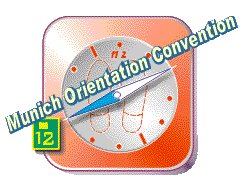Actual orientation tools Fundamental weak points
When we plan a journey, we have to memorize at least information concerning locations where we have to CHANGE our direction. The picture right hand shows two such locations X and Y. Let's call the information on location X "memoX" and on location Y "memoY".. Consequently, this information must be adequate to command our muscles. |
|
What kind of information can it be? Are memoX and memoY DIRECTIONS?
Wrong !! It's not possible to memorize directions !! Did you know that?
We can only memorize ANGLES, that means, the space between
 |
- the desired direction and - a REFERENCE direction like north / wind / sun / polar star / wall line, a marcant point etc, see angle memoY, or - the own view/walk/drive/flight direction, see angle memoX = left hand |
If you don't believe this, try to write an example for an information memoX which isn't an angle but is adequate to command your muscles for a turn movement:
Fundamental weak point 1: missing reference directions
We need reference directions for the turn movement but everywhere signage only shows target NAMES, a poor and inadequate information.
 |
This sign seems to point to Eldorado but this way we can surely access thousands of other locations. Additional problem: can we be sure that Eldorado is right hand on reality? No, Eldorado can be ahead, behind or left hand. This could be a loop way. If you've lost orientation and you're obliged to use this sign as reference direction, this could even be dangerous. |
If on a moment of decision it's not possible to reconstruct the memorized reference direction, the memorized angle won't be valid at all. To use this angle could even be dangerous. |
 |
What kind of reference directions do YOU recommend? The front direction?
The Munich Orientation Convention recommends the indication of cardinal points acc. to Vertical Pointing(c).
Fundamental weak point 2: Degeneration
Average people only know right/left angles and don't dominate the 360 degrees system. The knowledge about cardinal points gets more and more lost, a compass is considered as an old fashioned tool. Average people memorize a long chain of left/right angles, nothing else.
Did you know that left/right confusions are absolutly usual ? Because of that left/right indications - like on X-ray photos - should be avoided.
What kind of angles do YOU recommend? Left/right? 360 degrees?
The Munich Orientation Convention recommends angles based on the division of the horizon into 12 directions (imaginary clock), used by soldiers, boy scouts, blind people, pilots etc. for more than 100 years.
weak point 3: names and pictures as source
 |
Our memory needs angles. |
|---|
But the usual source information is/are:
- NAMES
and/or
- PICTURES of the type YouAreHere / eAreHere

How do we convert this source into angles? .
 |
(simplified model) This complicated conversion happens on the left brain hemisphere via two bottle necks In case of unexpected situations, stress, disease etc., this fragile constellation causes an ORIENTATION COLLAPSE: you'll depend on external information. The external information is the one described. In most cases you'll have to guess. |
Is this a good system? Navigation devices are a copy of this system and accelerate this degeneration.
The Munich Orientation Convention recommends: - angles which can be memorized directly and - position codes which allow to easily deduce the needed angle.
|
 |
Such innovations should also be implemented on navigation devices as an additional smart option. All other orientation tools will remain.

